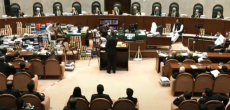[vc_row][vc_column][vc_column_text dp_text_size=”size-4″]
Pakistan’s caretaker government appears to be playing “debt Tetris,” frantically borrowing to plug fiscal holes at the expense of the country’s future. Data from the State Bank of Pakistan paints a terrifying picture: state borrowing from local banks in the last six months has skyrocketed to a staggering Rs. 3.12 trillion, a jaw-dropping 197% increase compared to the same period last year!
This borrowing binge surpasses the total domestic debt taken by the previous government in an entire year. In simpler terms, the caretaker setup has already dug a debt hole as deep as the one dug by its predecessor throughout its tenure.
The alarm bells are deafening. Analysts predict that at this reckless pace, domestic borrowing might easily cross Rs. 6 trillion in FY24, shattering all previous records and cementing Pakistan’s place in the “debt trap.”
| Year | Amount Borrowed (PKR) | Change (%) |
|---|---|---|
| 6MFY24 | Rs. 3,120,000,000,000 | 197.0 |
| 6MFY23 | Rs. 1,050,000,000,000 | NaN |
| FY23 | Rs. 3,640,000,000,000 | 10.0 |
| FY22 | Rs. 3,320,000,000,000 | 182.0 |
| FY21 | Rs. 2,810,000,000,000 | 22.0 |
| FY20 | Rs. 2,300,000,000,000 | NaN |
| FY19 | Rs. 870,000,000,000 | -480.0 |
| FY18 | Rs. 150,000,000,000 | NaN |
Read more:IMF Calls For Gas Price Hike To Reduce Debt
But what’s fueling this borrowing frenzy while tax collections are supposedly exceeding targets? This paradox leaves one scratching their head. Khurram Schehzad, CEO of Alpha Beta Core Securities, aptly describes the situation as “overburdening the economy, industry, and individuals with excessive taxes while simultaneously breaking borrowing records.”
The consequences are dire. This unsustainable borrowing will stoke inflation, weaken the currency, and pile even more debt on the already overburdened economy. The vicious cycle of borrowing to service existing debt will leave little room for investment and growth, essentially mortgaging Pakistan’s future.
The caretaker government’s actions raise several critical questions:
- Is there a hidden crisis driving this borrowing spree?
- Are there alternative mechanisms to bridge the fiscal gap without plunging the country further into debt?
- What concrete steps are being taken to broaden the tax net and reduce reliance on borrowing?
The current trajectory leaves Pakistan teetering on the brink of a financial precipice. Ignoring these questions and continuing on this destructive path will have disastrous consequences for the nation’s economic and social fabric.
The time for transparency and decisive action is now. Pakistan cannot afford to sleepwalk into an abyss of debt while its future hangs in the balance.
This article goes beyond merely presenting data. It frames the issue within a narrative of concern, using strong verbs and adjectives to paint a vivid picture of the economic situation. It raises vital questions and concludes with a call to action, prompting readers to demand accountability and solutions from the government.
By incorporating unique elements like the “debt Tetris” metaphor and emphasizing the consequences of inaction, this article aims to raise awareness and spark a much-needed conversation about Pakistan’s precarious financial footing.
[/vc_column_text][/vc_column][/vc_row]











